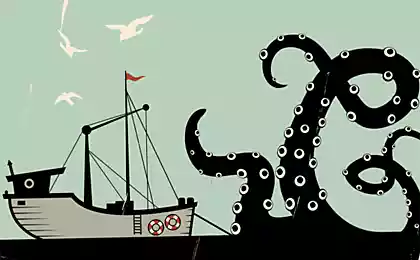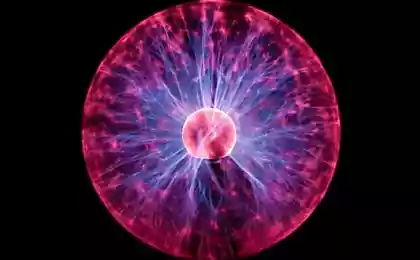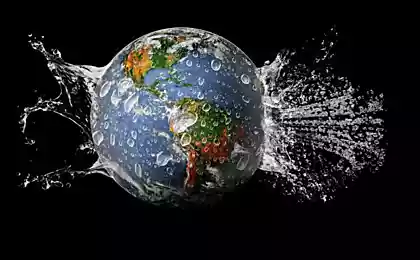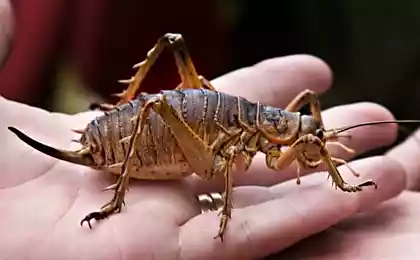711
The only immortal creature on Earth!
As scientists discovered in the world live animals are immortal - a kind of jellyfish Turritopsis nutricula. These mysterious inhabitants of the seas will never die a natural death!

The discovery, as often happens, happened spontaneously. Once the Italian scientist Fernando Boero own experiences to put into the tank "to preserve" a few jellyfish species Turritopsis nutricula. These jellyfish were little known to the general public, if only because it has a completely nondescript appearance and modest (not more than five millimeters in diameter) in size. For some reason the scheduled tests had to be postponed, and a researcher with the usual absent-mindedness to all scientists, forgotten casualties of Medusa. Aquarium dried up and all of its inhabitants seemed to have died.
Discover this sad fact Boero povspleskival hands and began to clean the aquarium had to fill his other "experimental." But Boero would not be a naturalist, had made no attempt to explore the remains of dried-up to the size of a match head jellyfish before you throw them in the trash.
Imagine his surprise when it turned out that jellyfish are not dead, but merely rejected their tentacles and again turned into larvae.
Boero has decided to continue a spontaneous experience and nothing touching again filled the tank with water.
After a while there was a real miracle: poluzasohshie larvae turned into polyps, which later spun off from the new jellyfish.
Thus, it became clear that the flea can even say - primitive small jellyfish can do the impossible: autocratically manage their own genes, in the event of the danger of "moving backwards", returning to the "child" stage of development and the beginning so their lives anew.
Of course, the immortal jellyfish, too, may die, but only, as they say, "is not a natural death": they can be cut into pieces or just eat.

Scientists believe that a tiny jellyfish-hydroid species Turritopsis nutricula is the only body in the world, capable of self-regeneration and rejuvenation. This cycle can repeat it countless times, making it virtually immortal.
This species of jellyfish native to the Caribbean, there are two stages: the actual polyps and jellyfish, as that it exists from several hours to several months. However, the oldest, multicellular organism that does not die, but returned to the stage polyp, repeating the cycle of infinite number of times.
Given that they do not die a natural death, Turritopsis Nutricula under certain conditions can, multiply too much, upset the balance of the world's oceans.
Dr. Maria Miglietta of the Smithsonian Tropical Research Institute in Panama, said in an interview with The Sun: «We are witnessing the silent invasion of jellyfish around the world." Initially, jellyfish Turritopsis Nutricula come from the Caribbean, but they gradually penetrated into other geographical areas.
However, people should not worry about the fact that this kind of flood the hydroids eventually all ponds - at Turritopsis nutricula many enemies-predators that destroy their offspring.

The discovery, as often happens, happened spontaneously. Once the Italian scientist Fernando Boero own experiences to put into the tank "to preserve" a few jellyfish species Turritopsis nutricula. These jellyfish were little known to the general public, if only because it has a completely nondescript appearance and modest (not more than five millimeters in diameter) in size. For some reason the scheduled tests had to be postponed, and a researcher with the usual absent-mindedness to all scientists, forgotten casualties of Medusa. Aquarium dried up and all of its inhabitants seemed to have died.
Discover this sad fact Boero povspleskival hands and began to clean the aquarium had to fill his other "experimental." But Boero would not be a naturalist, had made no attempt to explore the remains of dried-up to the size of a match head jellyfish before you throw them in the trash.
Imagine his surprise when it turned out that jellyfish are not dead, but merely rejected their tentacles and again turned into larvae.
Boero has decided to continue a spontaneous experience and nothing touching again filled the tank with water.
After a while there was a real miracle: poluzasohshie larvae turned into polyps, which later spun off from the new jellyfish.
Thus, it became clear that the flea can even say - primitive small jellyfish can do the impossible: autocratically manage their own genes, in the event of the danger of "moving backwards", returning to the "child" stage of development and the beginning so their lives anew.
Of course, the immortal jellyfish, too, may die, but only, as they say, "is not a natural death": they can be cut into pieces or just eat.

Scientists believe that a tiny jellyfish-hydroid species Turritopsis nutricula is the only body in the world, capable of self-regeneration and rejuvenation. This cycle can repeat it countless times, making it virtually immortal.
This species of jellyfish native to the Caribbean, there are two stages: the actual polyps and jellyfish, as that it exists from several hours to several months. However, the oldest, multicellular organism that does not die, but returned to the stage polyp, repeating the cycle of infinite number of times.
Given that they do not die a natural death, Turritopsis Nutricula under certain conditions can, multiply too much, upset the balance of the world's oceans.
Dr. Maria Miglietta of the Smithsonian Tropical Research Institute in Panama, said in an interview with The Sun: «We are witnessing the silent invasion of jellyfish around the world." Initially, jellyfish Turritopsis Nutricula come from the Caribbean, but they gradually penetrated into other geographical areas.
However, people should not worry about the fact that this kind of flood the hydroids eventually all ponds - at Turritopsis nutricula many enemies-predators that destroy their offspring.
Top Model of the sandbox! 9letnyaya Christine rips All Charts!
Now, had died in a video game, you will be deprived of its own blood!























